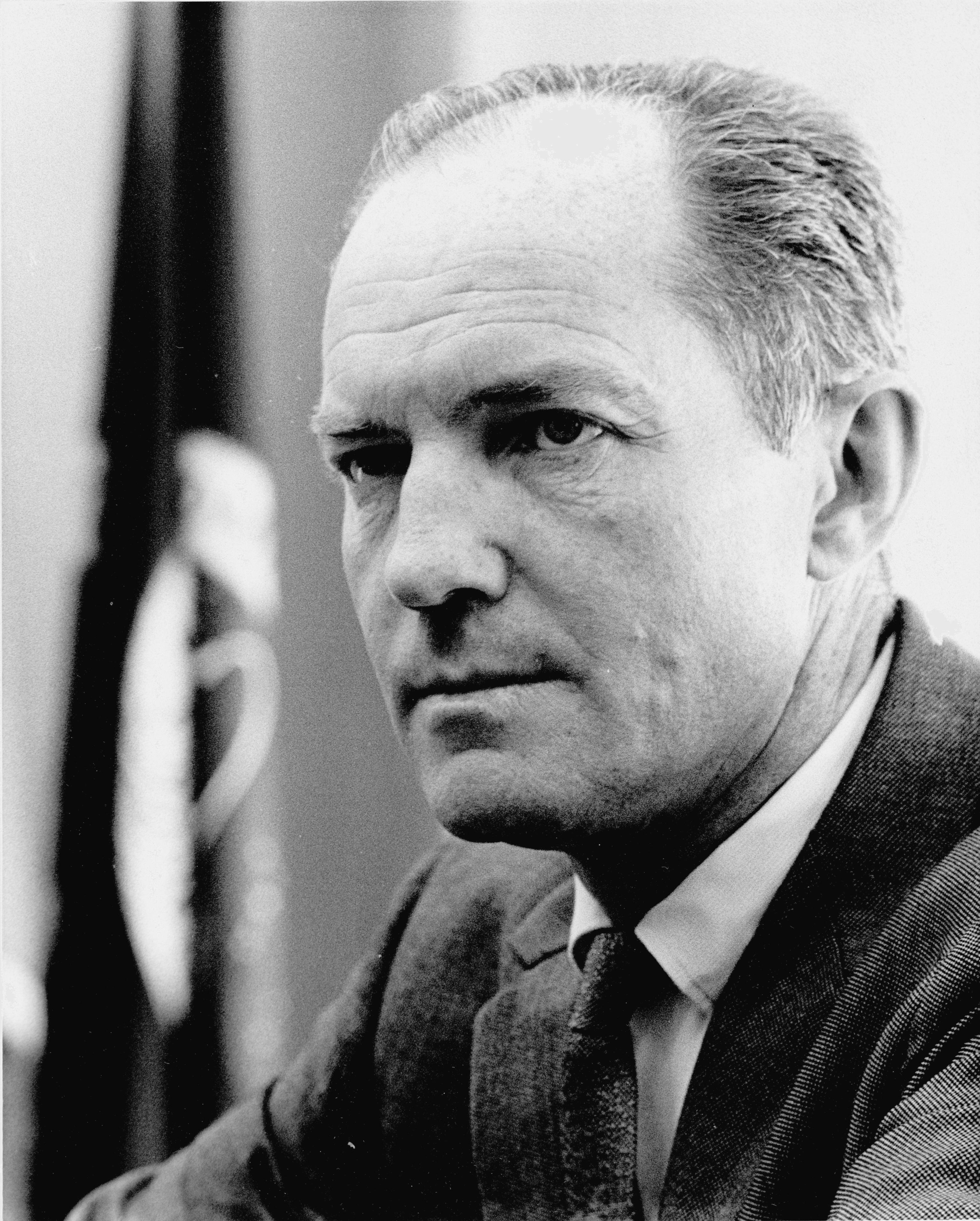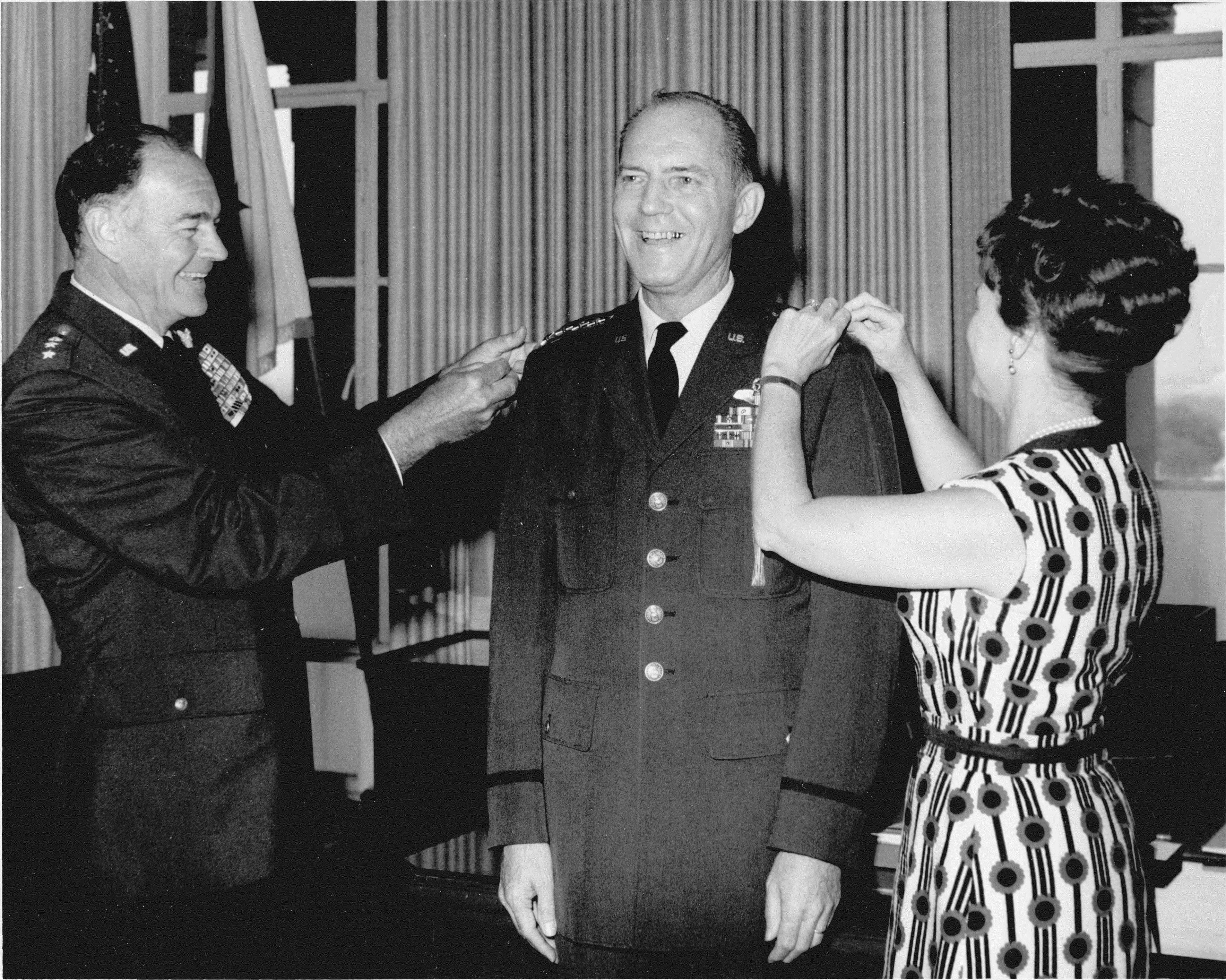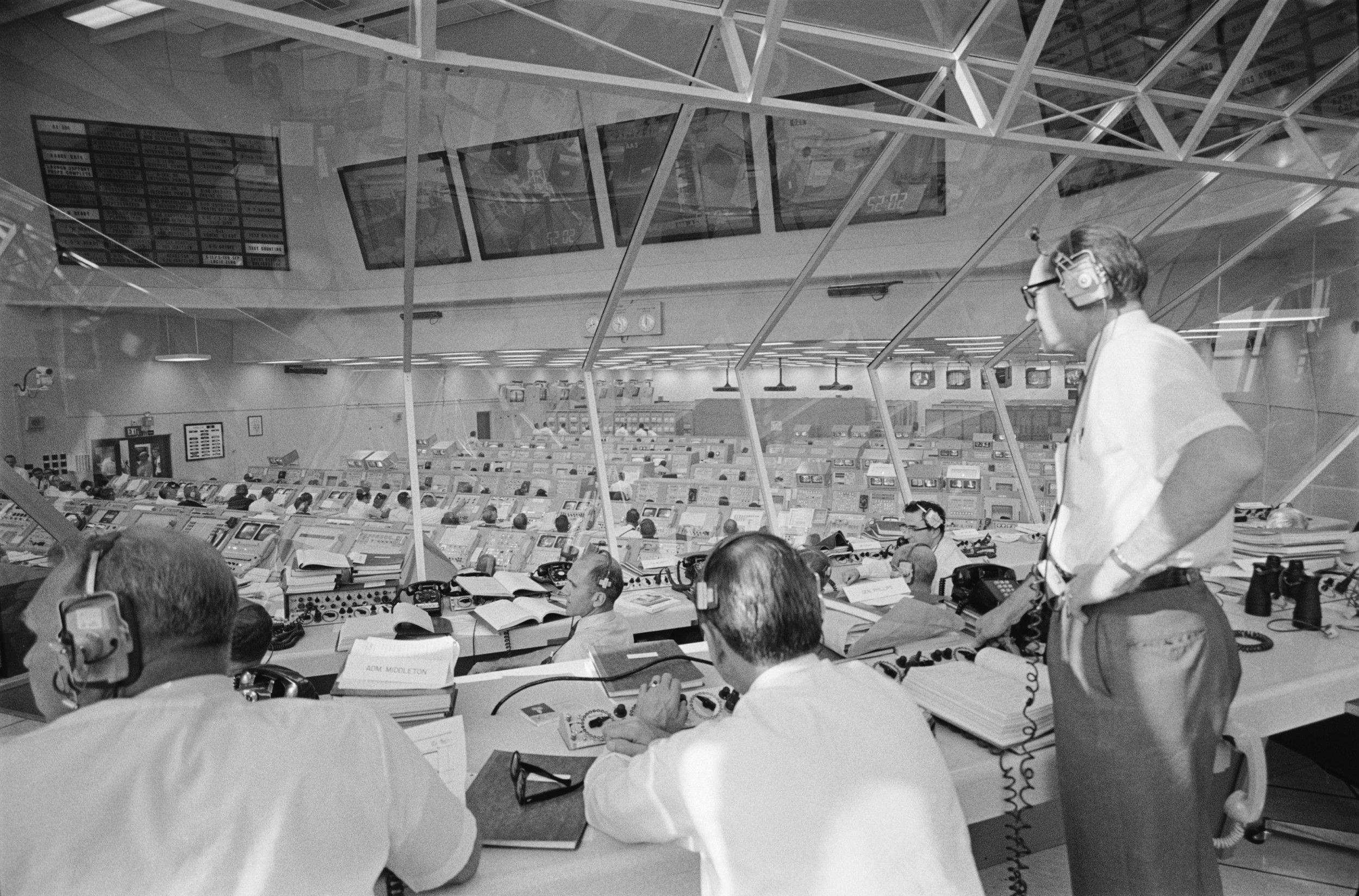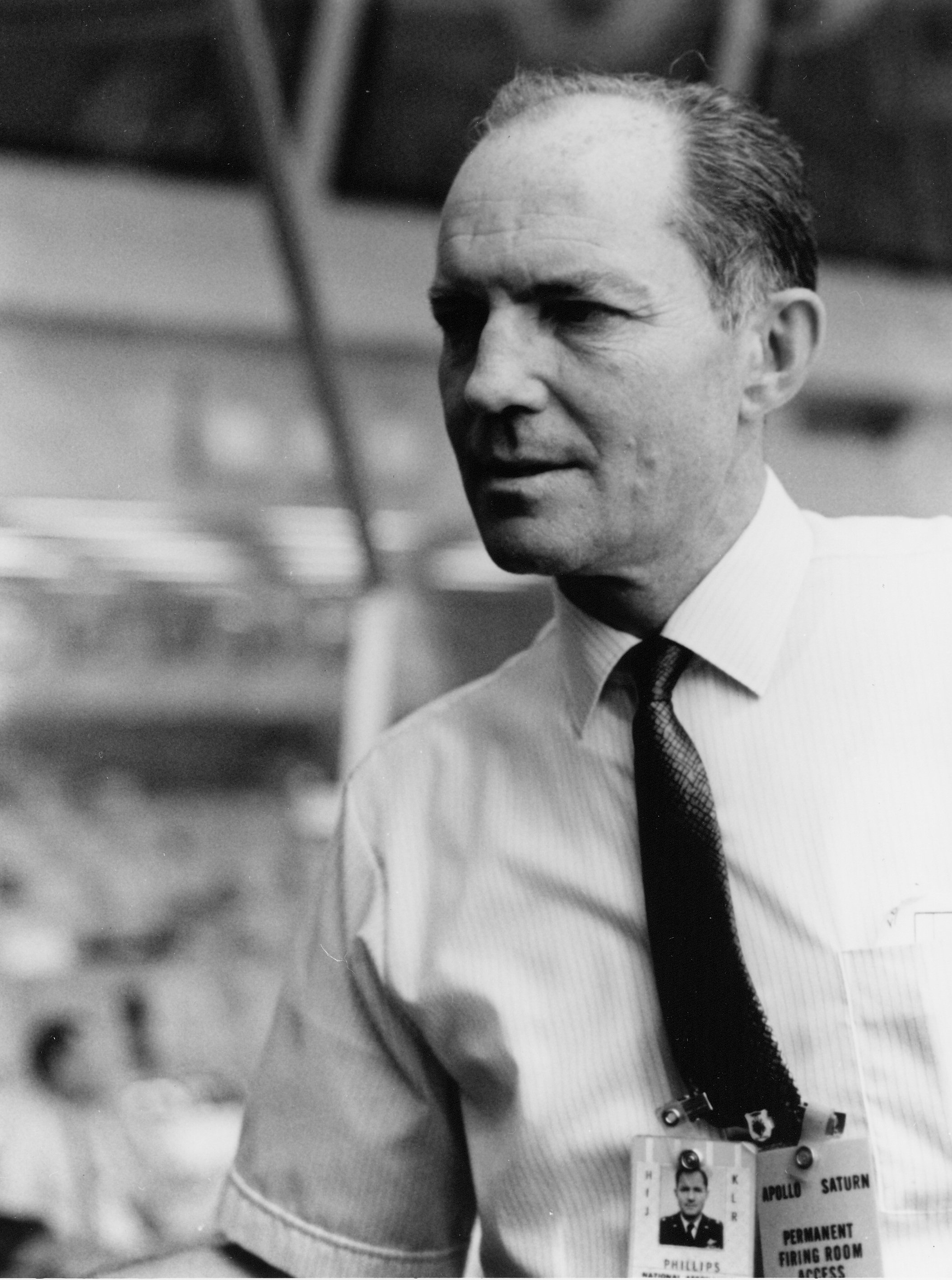It has been a half century since humankind first set foot on the lunar surface. The monumental undertaking of putting men on the moon took thousands of people across the entire United States and cost $25.4 billion in then-year dollars ($153 billion in 2019 dollars). NASA’s Project Apollo was behind schedule and experienced cost overruns almost from the beginning, their leadership looked to the Air Force for management guidance and they requested the assistance of one specific Air Force officer, Brig. Gen. Samuel C. Phillips.
Born in Springerville, Arizona in 1921, Phillips moved to Cheyenne, Wyoming at a young age where he attended public schools until his graduation in 1938. He continued his education at the University of Wyoming, earning a Bachelor of Science degree in Electrical Engineering just four years later. That same year he was commissioned as a second lieutenant of infantry in the regular Army. Transferring to the Air Corps a short time later, Phillips earned his pilots wings in 1943 and was immediately sent to serve with the 364th Fighter Group, Eight Air Force in England where he served two combat tours of duty in which he earned the Distinguished Flying Cross and Oak Leaf Cluster, Air Medal with seven Oak Leaf Clusters and the French Croix de Guerre. After the war, then-Major Phillips was assigned to the European Theater Headquarters in Frankfurt, Germany.
His next assignment in 1947, took him to Langley AFB, Virginia as Director of Operations for the 1st AACS (Airways and Air Communications Service) Wing. His assignment shortened after being selected for graduate training at the University of Michigan in 1948, Phillips received his Master of Science degree in Electrical Engineering in 1950. Following graduation, he received orders to join the Engineering Division of the Air Materiel Command at Wright-Patterson AFB, Ohio  where he remained in research and development work for the next six years, interrupted only by a three month assignment in Eniwetok as an electronics officer working with atomic energy experiments during Operation Greenhouse in 1951 and three months at the Air Command and Staff School, Maxwell AFB, Alabama, also in 1951.
where he remained in research and development work for the next six years, interrupted only by a three month assignment in Eniwetok as an electronics officer working with atomic energy experiments during Operation Greenhouse in 1951 and three months at the Air Command and Staff School, Maxwell AFB, Alabama, also in 1951.
During his assignment to Wright-Patterson AFB, Phillips served as Director of Operations in the Armament Laboratory; Project Officer on the Boeing B-52 bomber program and Chief of the Air Defense Missiles Division, working with missiles such as the Hughes AIM-4 Falcon and Boeing IM-99 BOMARC. Now a Colonel-selectee, Phillips returned to England in in 1956 as Chief of Logistics for Strategic Air Commands 7th Air Division. He participated in writing the international agreement with Great Britain on the use of the Thor IRBM and later as the 7th Air Division Director of Materiel, he assisted in the completion of Thor IRBM installations for turnover to the RAF for which he was awarded the Legion of Merit. It was here that he first caught the attention of Gen. Bernard Schriever’s deputy, Brig. Gen. Charles Terhune, Jr. Impressed with his work on the Thor missile system, Schriever brought him into Minuteman missile program.
Upon his return to the United States in 1959, Phillips was assigned as Director of the Minuteman missile program for the Ballistic Missiles Division of the Air Research and Development Command in Los Angeles, California. He earned the reputation as a leader that was willing to make the tough calls, not just for scheduling, but to balance cost, schedule as well as performance. He was nominated for promotion to Brigadier Gen. in 1961, becoming the youngest general officer in the Air Force at the age of 39, and remained as Director of the program until early 1964.
By this time the Apollo program was well underway and by 1963, NASA had become an agency with formidable technological talent, but lacked the large program managerial experience that would be necessary for a program the size of Apollo. NASA Administrator James Webb turned to industry and the military for assistance, bringing in Dr. George Mueller from Space Technology Laboratory (STL, later TRW) as the Associate Administrator for Manned Space Flight. STL was the Science and Engineering Technical Direction contractor for the Minuteman program, so Mueller knew he wanted Phillips for his team. Phillips was hoping to return to SAC and was reluctant to join NASA, but jumped right in and took charge. His take charge attitude overcame resistance on many levels, from the micromanagement of many independent NASA centers to the idea of releasing development efforts to contractors.
 During the early years of the space program, few people cared about NASA’s cost overruns and delays, the leaders were more concerned about overtaking the Russians in the space effort than about cost and schedule. Eventually this became sore point with many involved. Project Mercury’s cost overruns began within a month of its approval and continued throughout the program. McDonnell Aircraft’s Mercury capsule contract went from an initial $19,450,000 to a total of $143,413,000 while project Gemini’s cost went from $531,000,000 to an astounding $1,354,000 in just two years.
During the early years of the space program, few people cared about NASA’s cost overruns and delays, the leaders were more concerned about overtaking the Russians in the space effort than about cost and schedule. Eventually this became sore point with many involved. Project Mercury’s cost overruns began within a month of its approval and continued throughout the program. McDonnell Aircraft’s Mercury capsule contract went from an initial $19,450,000 to a total of $143,413,000 while project Gemini’s cost went from $531,000,000 to an astounding $1,354,000 in just two years.
NASA Administrator Webb knew that Apollo could not afford these types of overruns or delays if they were to hit their target of landing on the moon by the end of 1969. Mueller knew that Phillips had experience with keeping Minuteman on schedule and within predicted cost. Believing that NASA needed to adopt Air Force management methods, Mueller decide that Phillips was the best man to help NASA learn and made a request to Gen. Schriever to assign Phillips to NASA. Although reluctant to assign his best manager to NASA, Schriever recognized the benefits. With the Air Force developing the Dyna-Soar manned spacecraft as well as planning for the Manned Orbiting Laboratory, they could gain experience on NASA manned spaceflight programs. Initially assigned as Deputy Apollo Program Director, this was quickly changed to Apollo Program Director nine months later.
 Shortly after his arrival to NASA, Phillips recognized that “NASA had developed to be a very, very professional technical organization, but they had almost no management capability nor experience in planning and managing large programs”. Phillips realized he would need reinforcements to assist in the transformation of NASA and made a request to Gen. Schriever in January 1964 requesting more Air Force personnel be assigned to the Office of Manned Space Flight’s control positions. Schriever wished to have a more detailed formal request and Phillips created a list of 55 positions that he wished to be filled with Air Force officers. This became known as ‘Project 55’ as those Air Force officers took positions in key managerial positions throughout the Apollo program, primarily in project control and configuration management offices.
Shortly after his arrival to NASA, Phillips recognized that “NASA had developed to be a very, very professional technical organization, but they had almost no management capability nor experience in planning and managing large programs”. Phillips realized he would need reinforcements to assist in the transformation of NASA and made a request to Gen. Schriever in January 1964 requesting more Air Force personnel be assigned to the Office of Manned Space Flight’s control positions. Schriever wished to have a more detailed formal request and Phillips created a list of 55 positions that he wished to be filled with Air Force officers. This became known as ‘Project 55’ as those Air Force officers took positions in key managerial positions throughout the Apollo program, primarily in project control and configuration management offices.
Phillips understood that NASA engineers would be resistant to his primary control technique, configuration management. Due to the Apollo programs rapid growth, the program would require better communication and consistent language between NASA and its contractors. He believed that good procedures had a high probability of preventing catastrophic oversights or shortcuts. Implementation of configuration management required that NASA engineers set firm Apollo requirements and specifications. The complex Apollo program allowed opportunities for Phillips to take very calculated risks in achieving balance between scheduling, performance and cost management. Phillips treated the NASA contractors as cooperative partners throughout the program. When they failed to perform, he took swift action. North American Aviation (NAA) built several Apollo components and some were beset with scheduling, cost and performance problems. Phillips assembled a team of nearly 100 NASA experts for a management review of NAA’s progress. He regarded frank communication with contractors as essential and this report fully reflected that belief. The “Phillips Report” as it became to be known, criticized nearly every element of NAA’s management. Although a scathing review of NAA, this report along with other reviews conducted or ordered by Phillips led to changes in management and substantial improvements in performance at NAA.
After this, NASA clamped down on North American Aviation to implement better management and planning methods, initiating another audit on NAA and was wrapping up in January 1967 when crisis struck the Apollo program. At 6:31pm on January 27, fire struck inside the Apollo 1 capsule during a routine ‘plugs out’ test. The three astronauts inside, Gus Grissom, Edward White and Roger Chaffee died from asphyxiation before launch personnel could get to them. A NASA investigation determined the causes to have been faulty wiring, underestimation of the dangers of an all-oxygen environment and a capsule design that prevented immediate egress. Despite a very detailed search, Congress found no fault in Phillips management system. Unfortunately, during the Congressional investigation a leaked copy of the ‘Phillips Report’ ended up in the hands of then-Senator Walter Mondale and he used it as a tool to criticize NASA in the Senate hearings investigating the fire.
Phillips continued to make critical decisions on a daily basis, the best example being his decision to change the flight plan for Apollo 8. The original plan for Apollo 8  was an earth orbital mission to test the lunar module (LM), but delays at Grumman put the LM behind schedule and Phillips proposed an idea to Webb (that Apollo Spacecraft Manager, George Low, had originally suggested) of sending Apollo 8 on a circumlunar flight to the moon. Webb thought that Phillips and Low was placing the entire Apollo program at risk and he had a good point. Apollo 7 had yet to fly and the unmanned Saturn V flight of Apollo 6 had only been nominally successful. Phillips was convinced that his team could solve the issues and it was Phillips and NASA Deputy Administrator Thomas Payne that convinced Webb to approve the Apollo 8 flight plan pending a successful completion of the Apollo 7 mission. In May 1968, Phillips was nominated for promotion to Lieutenant Gen..
was an earth orbital mission to test the lunar module (LM), but delays at Grumman put the LM behind schedule and Phillips proposed an idea to Webb (that Apollo Spacecraft Manager, George Low, had originally suggested) of sending Apollo 8 on a circumlunar flight to the moon. Webb thought that Phillips and Low was placing the entire Apollo program at risk and he had a good point. Apollo 7 had yet to fly and the unmanned Saturn V flight of Apollo 6 had only been nominally successful. Phillips was convinced that his team could solve the issues and it was Phillips and NASA Deputy Administrator Thomas Payne that convinced Webb to approve the Apollo 8 flight plan pending a successful completion of the Apollo 7 mission. In May 1968, Phillips was nominated for promotion to Lieutenant Gen..
With the Apollo program running on track, Phillips continued to lead the Apollo program through the first moon landing and left the agency in September 1969 to become Commander of the Space and Missile Systems Division at Air Force Systems Command in Los Angeles. Leaving the Missile Division in August, 1972, Phillips became director of the National Security Agency/Chief of Central Security Service. The following year he was nominated for his fourth star as he took command of the Air Force Systems Command at Andrews AFB, Maryland. He served in this capacity until his retirement on September 1, 1975.
His retirement did not end his connection with NASA. In 1986, following the Space Shuttle Challenger accident, NASA Administrator Dr. James Fletcher requested Phillips lead a team to look at NASA’s organization and management. He found that the program management discipline he instilled in Apollo had eroded in the Space Shuttle and Space Station programs. Fletcher adopted many of the recommendations Phillips provided to the extent that Phillips recognized positive changes when he was asked to return in 1988.
In addition to his Apollo legacy, at least eight former subordinates of Phillips became general officers; among them are Gen. Lew Allen, former Chief of Staff, Lt. Gen. Abrahamson, former astronaut, Space Shuttle Program Director & Director of the Strategic Defense Initiative, and Lt. Gen. James Clapper, former Director of National Intelligence. Phillips passed away on January 31, 1990 at the age of 68 and was buried with honors at the United States Air Force Academy Cemetery, Colorado Springs, Colorado.
Phillips received numerous awards, throughout his illustrious career including the Distinguished Flying Cross, the French Croix de Guerre, the Legion of Merit, the Air Force Distinguished Service Medal and the Distinguished Service Medal from NASA.
For further reading:
Courtney G. Brooks, James M. Grimwood, & Loyd S. Swenson Jr., Chariots for Apollo: A History of Manned Lunar Spacecraft, NASA: Washington D.C., 1979.
Roger D. Launius, Apollo’s Legacy: Perspectives on the Moon Landings, Washington: Smithsonian Books, 2019.
Eugen Reichl, Project Apollo: The Early Years, 1960-1967, Schiffer Publishing Ltd., 2016.
Eugen Reichl, Project Apollo: The Moon Landings, 1968-1972, Schiffer Publishing Ltd., 2017.